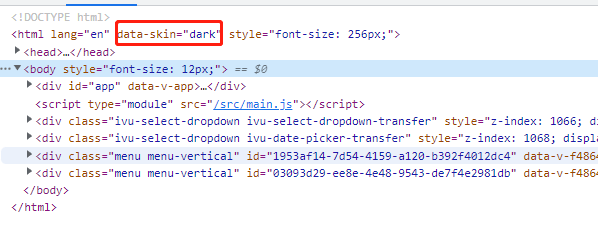换肤
换肤是基于 scss 实现的,通过 documentElement 中的 web-basic-skin 来切换不同的主题
目录结构
├── theme # 存储皮肤的文件夹
│ ├── index.scss # 引入皮肤以及全局公用变量
│ ├── dark.scss # 深色系皮肤
│ ├── light.scss # 浅色系皮肤
│ └── ...
└── handle.scss # 用来处理换肤
handle.scss 如何处理
通过使用 scss 的语法 @mixin 和 @function 完成 css 的处理
/**
* 在_themes.scss里面定义好自己需要的东西在该文件夹下面进行遍历和定义
**/
@import './themes/index.scss';
//遍历主题map
@mixin themeify {
@each $theme-name, $theme-map in $themes {
//!global 把局部变量强升为全局变量
$theme-map: $theme-map !global;
//判断html的data-skin的属性值 #{}是sass的插值表达式
//& sass嵌套里的父容器标识 @content是混合器插槽,像vue的slot
[web-basic-skin='#{$theme-name}'] & {
@content;
}
}
}
//获取background-color背景颜色
@mixin background($color) {
@include themeify {
background: themed($color) !important;
}
}
系统中是如何使用皮肤
在 document 中创建皮肤变量
在 App.vue 中
<script setup>
function getTheme() {
// 获取localStorage中存进去的type
console.log(localStorage.getItem('type'));
/**
* 判断 localStorage 中的 type 是否为空,如果为空的话,就给默认的颜色(页面初始化的颜色),如
* 果不为空的话就将对应获取到的值给到 web-basic-skin
**/
if (localStorage.getItem('type') !== null) {
window.document.documentElement.setAttribute('web-basic-skin', localStorage.getItem('type'));
} else {
window.document.documentElement.setAttribute('web-basic-skin', 'dark');
}
}
onMounted(() => {
getTheme();
});
</script>
这时在 dom 中可以看到如下图所示

全局引入皮肤变量
在 vite.config.js 中 通过 css 的配置使皮肤变量全局可用
import { defineConfig } from 'vite';
export default defineConfig(() => {
return {
css: {
preprocessorOptions: {
scss: {
additionalData: `@import '@/style/handle.scss';`,
},
},
},
};
});
如何创建一个新的皮肤
在 theme 中创建一个需要的皮肤文件,例如 dark.scss,之后在 index.scss 中引入该文件并且在 index.scss 中的 $themes 中使用该变量就完成了该皮肤在系统中的配置
@import './dark.scss';
$themes: (
dark: $dark,
);
dark.scss 填写
声明各个颜色的变量
命名规范: 功能名称(btnPrimary) + 样式名称(Bg) + 样式状态(Hover) 采用驼峰式命名
$dark: (
btnPrimaryBg: linear-gradient(180deg, #2b84e2 0%, #083a78 100%),
);
在 scss 中皮肤变量的使用
这里以更改 iview 中的组件 button 为例
.ivu-btn-primary {
padding: 0 22px;
height: 34px;
line-height: 34px;
@include background('btnPrimaryBg');
opacity: 1;
border-radius: 4px;
border: none;
}